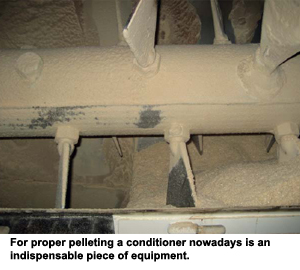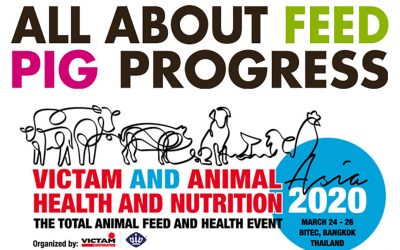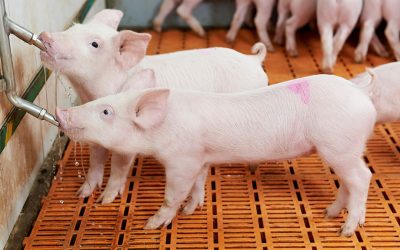Hygienic feed at high capacity with superconditioning

With the focus on combating the bad bugs in animal feed thermal treatment seems to be the most successful technique and during the years many systems have been developed. However, feed production lines have become larger and can the conditioning systems keep pace with increased yields? When choosing a system, which one is better? Andritz Feed & Biofuel presented a paper on this subject at the IFF Feed processing conference during Victam International 2011 in May in Cologne, Germany.
There are several requirements that determine a successful conditioning of mash feed.
- Does the feed have to be pelleted or not after conditioning and which hygienic feed quality is required?
- In other words, what reduction of bacteria is desired?
- Furthermore, is the conditioning of the mash also meant to enhance pellet quality and is starch gelatinisation required?
- Does the end user have a say and obligate governmental regulations a certain feed sanitation?
- How much liquid can be added? Does the type of conditioning allow enough flexibility in feed formula calculations?
- Can the conditioner continuously feed the modern high capacity pelleting lines?
- How heat sensitive are some of the feed ingredients?
- And finally, what are the investment and operating costs?
All in all enough prerequisites to make the choice for an efficient operating conditioning system not an easy one.To fulfill these requirements it all has to start with the pre-heating and pre-moistening conditioner. With hygienisation of feeds one always has to work with the three essentials of conditioning: moisture, temperature and time. To make optimum use of these essentials the barrel of the conditioner has to be equipped with a shaft that has adjustable paddles. The proper setting of the paddles secures a uniform filling of the barrel and an optimum feed-steam-liquid interaction. A multi-point steam injection (Figure 1) ensures optimum steam absorption according to the properties of the specific feed composition and milling degree.
This way meal balls are avoided around drops of condensate and drops of added liquid. With steam addition at several points in the barrel, optimum conditioning is also established through a step wise distribution of steam into the compound feed while passing the mixer according to the absorbability of the compound. The addition of liquids should also occur with the steam injectors in the correct mixer position. The best way is to apply liquids in parallel to the steam direction, which improves the absorbability of the liquids.Conditioning also has a time issue. The required retention time is depending on the volume of the conditioner, the density of the product, the filling degree and the desired capacity. In formula: Retention time (sec) = Volume (ltr) × Density (0.xx) × Filling degree (0.xx) × 3.6/Cap (tph).
Feed expander benefits
The correct conditioning of a feed compound is necessary in order to obtain a good pellet quality and an effective utilisation of the pelleting or extrusion installation. Conditioning improves compressibility and binding properties of feed mixtures. And feed expanders offer additional pellet mill throughput and improved quality compared to time-temperature conditioning alone. Also Salmonella is easier to kill in an expander. Salmonella is destroyed after 45 seconds of steam conditioning at 85°C, but already after four seconds at 95°C in an expander following a conditioner. Despite these facts meat buyers or authorities sometimes require thermal treatments of 60 or 120 seconds at specific temperatures. When including liquid feed ingredients the kneading which takes place in the feed expander offers clear benefits to physical feed quality.
Comparing a regular corn-soy poultry feed run through an expander-pelleting process or an extended time conditioning-pelleting process results in a 20-35 tph higher capacity in favour of the expander process (70-90 tph vs 50-55 tph) with the same or better pellet quality.An expander adds to the flexibility of the feed manufacturing process. The short bust of energy by high temperature (Figure 2) and pressure provides a high degree of starch modification (gelatinisation). The use of an expander results in a lower percentage of fines, better physical pellet quality ( PDI), increased pellet mill capacity and increased liquid addition. The expander also helps in these current times of high priced raw materials to use alternative ingredients with less consideration for binding properties of the feedstuffs and thus can result in lower cost formulating. The machine then adds to process flexibility.
Better animal performance
In expanded feeds bacteria are eliminated and growth-inhibiting substances are reduced resulting in a better digested feed and improved feed performance by the animals. Table 1 examples a broiler test with several pre-conditioning stages of the feed. The test clearly shows that the expander benefits bodyweight gain and feed conversion.Cost wise the use of an expander is often a bottleneck with decision makers because of the initial investment. However this can be gained back with higher capacity and lower power consumption of the pellet mill and better animal performance. Table 2 shows a cost and quality experience before and after a feed expander installation. From these data it also becomes obvious that investments in large plants are easier to calculate than in small facilities. Operational costs, labour and maintenance are in favour of large units.
Larger dimensions of pellet mills are providing higher energy efficiency due to both geometry and compression. Larger mills also benefit from higher tolerance to high temperature conditioning, as well as longer dwell time of feed in the die, which improves durability. Choking of the pellet mill is far less an issue in large units and with the right automation large machines start as quick as small machines.











